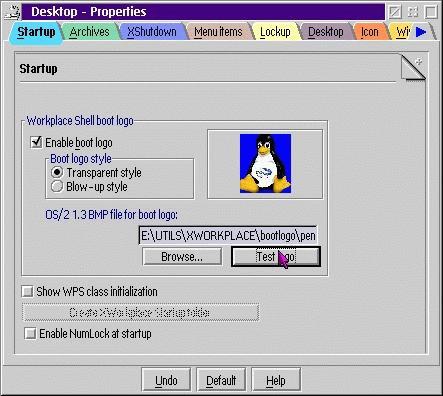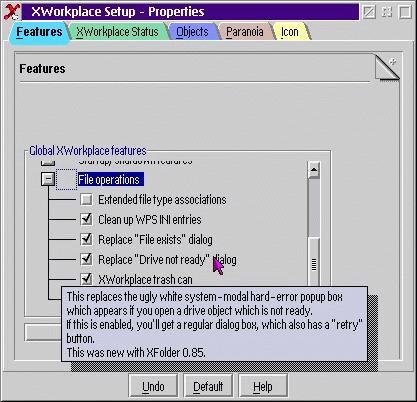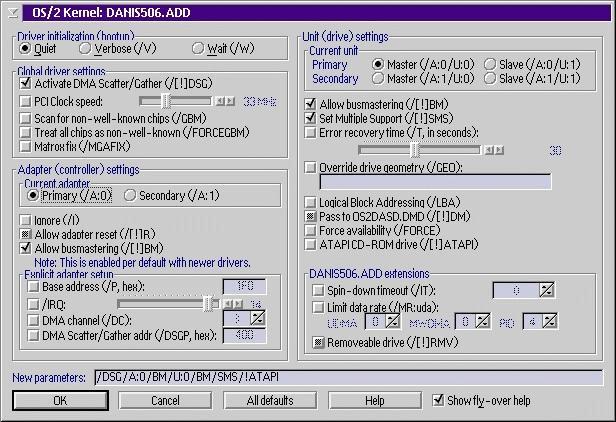 VOICE Home Page: http://www.os2voice.org |
[Previous Page] [Next Page] [Features Index] |
 VOICE Home Page: http://www.os2voice.org |
[Previous Page] [Next Page] [Features Index] |
|
By Don
Eitner ©July 2000 Don's Homepage: The 13th Floor - http://www.tstonramp.com/~freiheit/ XWorkplace V0.9.3: WarpIn V0.9.3: http://warpin.netlabs.org/ Author: Ulrich Moeller: ulrich.moeller@rz.hu-berlin.de |
Those who used XFolder will recall that it provided a wealth of new WPS tools.
These included an enhanced shutdown screen with reboot capability and the ability
to restart the WPS without a full system shutdown. XFolder also sported a slightly
enhanced startup folder which offered a configurable delay between the startup of
each item. Additionally, it offered folder popup menu editing where you could remove
common menu items or add a context menu entry for rapidly drilling down through
nested folders.
XWorkplace 0.93 still has all these features, but it includes so many more features
and enhancements that I couldn't possibly name them all here. Instead, let me point
out a few of the most significant or obvious changes.
Aside from the look of it, the installation was smooth and very quick. It detected
my existing XFolder 0.85 installation and used many of its configurations such as
what to show and what not to show on the WPS context menu. But so many of the features
have been enhanced since the 0.85 release that it didn't make sense for XWorkplace
to use all of my old settings, so it reverted to defaults on some others such as
shutdown/reboot options.
I don't recall being advised to reboot my system in order for changes to take
effect, but I did anyway just to be on the safe side -- well, that and I wanted
to try out the new desktop archiving features right away!

A replacement to the default WPS archiver allows the user to select when to create
a desktop archive (based on number of days since last archive, next reboot only,
every reboot, or when the INI files have changed by a selectable percentage).
An updated File tab in the WPS popup menu provides a more compact interface for
setting file attributes and Extended Attributes.
XWorkplace also now offers a Sound Scheme editor which fully replaces the OS/2
Warp 4 Sound object and manages to look much nicer. The volume dial gives a text
display of the setting (from 0-100) so there's no more guesswork involved. There
are also a few new sound events such as Folder Double Click, Hotkey Press, Menu
Selection, Open Menu, Restart WPS, and XWorkplace Shutdown. It's about time we had
a single interface for both randomly playing WAV files and setting up entire sound
schemes.
XWorkplace now includes a trashcan so we OS/2 users can be just like WinDOS,
MacOS, or BeOS users. When you delete a WPS object (be it a program or file) it
gets stuffed into the trashcan folder, from which you can later recover it by dragging
and dropping back to the desktop. There is also the option of having a dialog display
the progress of the delete operation, which also allows you to cancel said operation.

Another of XWorkPlace's more obvious features is that many of its vastly improved
settings notebooks now include fly-over (tooltips) descriptions. This fly-over help
looks, unfortunately, more like NPSWPS's (another WPS enhancer) folder drop shadows
than BubblePad's tooltips, but it's an extremely useful feature regardless of how
it looks. The fly-over help is nowhere so obvious as in the brand new OS/2 Kernel
settings notebook where the Drivers tab now lists device drivers you have installed
and, for some of them such as Daniela Engert's DaniS506.add, provides a full GUI
dialog for setting the driver's parameters. I found options for DaniS506.add that
I never knew existed, and setting them is as simple as clicking a checkbox.

The OS/2 Kernel notebook, of course, still provides a clean interface for manipulating
system path variables in your config.sys file as well as setting cache values for
FAT, HPFS, and CDFS file systems, setting the maximum allowable system threads to
keep your PC responsive, and setting virtual memory (swap file) size.
A feature that may be especially nice for laptop/notebook users is that XWorkplace
now also enhances OS/2's Mouse settings notebook. The most impressive feature I
saw in this is that you can now enable and disable the Comet Cursor feature (adds
a colorful tail to your mouse pointer so that it's easier to track on laptop displays)
without rebooting your system. In OS/2's default configuration, this is not possible.
One more obvious, amd quite helpful, feature of XWorkplace 0.93 is the inclusion
of the PageMage virtual desktops program. In true XWorkplace style, you get an easy
to understand configuration notebook interface for this right alongside your other
screen options (such as resolution and color depth).
And all of this is free under the GNU General Public License (GPL). The source
code for XWorkplace is available from OS/2 Netl@bs (http://www.netlabs.org/).
Judging by the XWorkplace User Guide ~Reference (in OS/2 .INF format and included
with the binary distribution of the program) this is now a collaborative effort
between Ulrich Moeller (author of XFolder) and Christian Langanke (author of Animated
Mouse Pointer for OS/2). I guess the only way to make this better would be to add
Daniela Engert and Alessandro Cantatore (of Styler/2 fame) to the project - or for
any other aspiring OS/2 developers to take the open source and modify it in amazing
new ways to keep OS/2 in the lead as far as usefulness and visual attractiveness.
Also, one new feature that sounds quite interesting, Extended file type associations,
claims to not work properly yet and that daily use is "NOT recommended".
Too bad because I'd like to know how it works and to see it in action. But this
is, as stated in the documentation, a developer release.
While the new sounds object has a lot more power than the one included with OS/2
Warp 4.0, there was one feature I liked more in the IBM version - having one listbox
of sound events and another of sound files. This made it incredibly easy to play
each sound in a selected directory in sequence to determine which might be best
for the currently chosen sound event. The way XWorkplace 0.93 has it, you have the
list of sound events and then a browse button which simply brings up a standard
file open dialog. You have to then select a sound and push the Play button, if you
don't like it you click Browse again, select a sound, push Play, etc.
Tooltips are also not currently available in all dialogs. The settings notebooks
don't tend to use them except in a few scattered places. I wouldn't mind seeing
tooltips become the standard because they are so context-sensitive.
Having a trash can from which accidentally deleted items can be recovered has
its uses, but the current version is missing a fundamental feature that lets you
specify that the trash should be emptied on every system shutdown or at regular
intervals (much as the desktop archiving tool works). The reason I bring this up
is that the trash is considered to be just another folder and, if you put something
into it that has the same name as an existing item in the trash, you get the prompt
asking you to rename the object. Well I might not be in the habit of manually emptying
my trash every day and don't necessarily want these prompts when I'm deleting stuff.